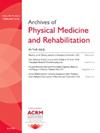战斗相关截肢后门诊处方药的聚类分析:一项回顾性研究。
IF 3.7
2区 医学
Q1 REHABILITATION
Archives of physical medicine and rehabilitation
Pub Date : 2025-08-01
DOI:10.1016/j.apmr.2025.02.006
引用次数: 0
摘要
目的:目的是:1)进行聚类分析,探索与战斗相关截肢后第一年门诊处方药物使用模式;2)分析处方药物聚类相关的患者特征。设计:对受伤后第一年国防部伤亡记录和门诊处方药物进行回顾性研究。美国医院处方服务(AHFS)药物类别的层次聚类分析。单位:军事截肢康复项目。参与者:2001-2017年在伊拉克和持久自由行动(OIF/OEF)中截肢的1651名美国军人,并服用门诊处方药。干预措施:n / a。主要观察指标:处方药物簇,患者特征。聚类分析确定了三个处方药物特征:聚类1)基线(n = 682)包括6个AHFS类别:泻药/泻药、抗惊厥药、半合成阿片类药物、抗抑郁药、非甾体抗炎药、联合阿片类镇痛药。这六个类别是所有三个概况(即基线药物)的一部分。第2组)基线加失眠(B+I) (n = 502):非典型抗精神病药物、抗焦虑药/镇静剂、美沙酮、苯二氮卓类药物、镇痛药/解热药和基线药物。第3组)基线加严重损伤(B+SI) (n = 467):抗凝血剂,5-HT 3受体拮抗剂,多种维生素,抗焦虑药/镇静剂,镇痛药/解热药和基线药物。基线组的特征为早期损伤年(85%,2001-2008)、中度/重度损伤(85%)、单截肢、慢性疼痛和创伤后应激障碍。B+I组的特点是损伤早期(62%),轻伤(16%),创伤性截肢率低,伤后并发症。B+SI组的特点是损伤年份较晚(2009-2017年,88%),严重/重度损伤(62%),多处截肢(42%),TBI(43%),并发症发生率高,处方。结论:聚类分析确定了损伤后第一年的三个门诊处方用药概况。所有的资料都包括止痛剂和精神治疗药物,但在特定的失眠药物、复合维生素和抗凝血剂方面存在差异。用药情况与损伤年限、损伤严重程度和损伤后并发症有显著相关性。研究结果为未来的研究和处方药实践提供了信息。本文章由计算机程序翻译,如有差异,请以英文原文为准。
Cluster Analysis of Outpatient Prescription Medications After Combat-Related Amputations: A Retrospective Study
Objectives
The objectives were (1) to conduct cluster analysis to explore patterns of outpatient prescription medications during the first year after combat-related amputations and (2) to analyze patient characteristics associated with prescription medication clusters.
Design
Retrospective study of Department of Defense casualty records and outpatient prescription medications during the first year postinjury. Hierarchical cluster analysis of American Hospital Formulary Service (AHFS) medication classes.
Setting
Military amputation rehabilitation program.
Participants
A total of 1651 US service members who sustained major limb amputations in Operations Iraqi and Enduring Freedom from 2001 to 2017 and had outpatient prescription medications.
Interventions
Not applicable.
Main Outcome Measures
Prescription medication clusters and patient characteristics.
Results
Cluster analysis identified 3 prescription medication profiles. Cluster 1: baseline (n=682) consisted of 6 AHFS classes: cathartics/laxatives, anticonvulsants, semisynthetic opioids, antidepressants, nonsteroidal anti-inflammatory drugs, and combination opioid analgesics. These 6 classes were part of all 3 profiles (ie, baseline medications). Cluster 2: baseline plus insomnia (B+I) (n=502): atypical antipsychotics, anxiolytics/sedatives, methadone, benzodiazepines, analgesics/antipyretics, and baseline medications. Cluster 3: baseline plus severe injury (B+SI) (n=467): anticoagulants, 5-HT3 receptor antagonists, multivitamins, anxiolytics/sedatives, analgesics/antipyretics, and baseline medications. The baseline cluster was characterized by early injury years (85%, 2001-2008), moderate/serious injuries (85%), single amputation, chronic pain, and posttraumatic stress disorder. Cluster B+I was characterized by early injury years (62%), minor injuries (16%), low rates of traumatic amputations, and postinjury complications. Cluster B+SI was characterized by later injury years (88%, 2009-2017), serious/severe injuries (62%), multiple amputations (42%), traumatic brain injury (43%), high rates of complications, and prescriptions.
Conclusions
Cluster analysis identified 3 outpatient prescription medication profiles during the first year postinjury. All profiles included analgesics and psychotherapeutics but differed in specific insomnia medications, multivitamins, and anticoagulants. Medication profiles had significant associations with injury years, injury severity, and postinjury complications. The results inform future research and prescription medication practices.
求助全文
通过发布文献求助,成功后即可免费获取论文全文。
去求助
来源期刊
CiteScore
6.20
自引率
4.70%
发文量
495
审稿时长
38 days
期刊介绍:
The Archives of Physical Medicine and Rehabilitation publishes original, peer-reviewed research and clinical reports on important trends and developments in physical medicine and rehabilitation and related fields. This international journal brings researchers and clinicians authoritative information on the therapeutic utilization of physical, behavioral and pharmaceutical agents in providing comprehensive care for individuals with chronic illness and disabilities.
Archives began publication in 1920, publishes monthly, and is the official journal of the American Congress of Rehabilitation Medicine. Its papers are cited more often than any other rehabilitation journal.

 求助内容:
求助内容: 应助结果提醒方式:
应助结果提醒方式:


